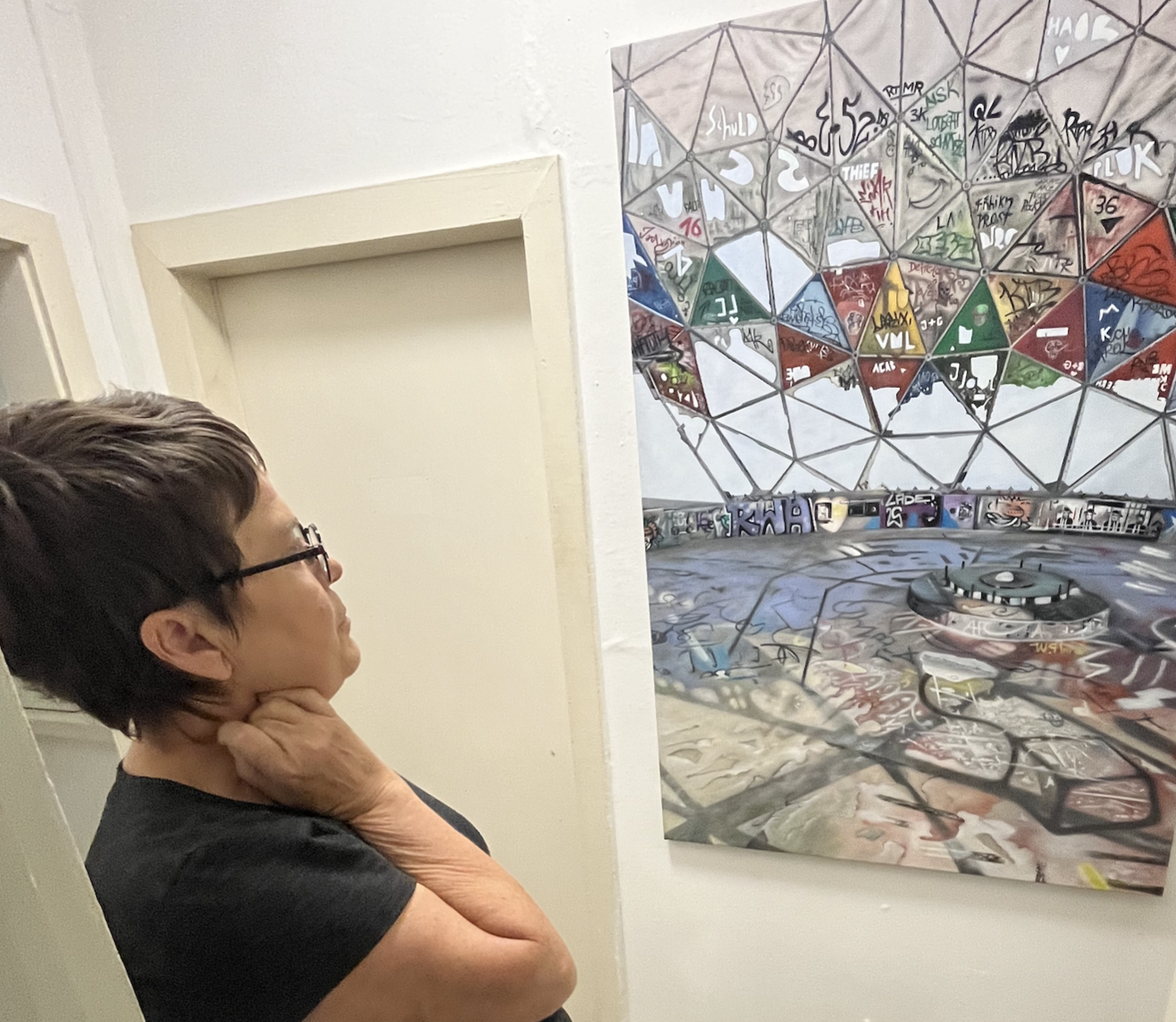Die Rollen sind verteilt und im Raum choreografiert. Die Geschichte hat einen Anfang. Die Show kann beginnen. Auf was warten wir? Ist das Bild ein Bild erst während der Ausstellung, oder bereits an seinem Entstehungsort? Oder erst danach? Wann ist der beste Augenblick? Wir sind vorausschauend abgesichert und blicken auf ein Ereignis in der Zukunft, ohne zu wissen, dass es bereits begonnen hat. Dabei sind wir selbst schon im Gegenüber mit dem Anderen, auf den wir warten. Gibt es einen Anderen, gibt es Erwartungen. Holz, Stein, Blei.
Die Skulpturen von Andrea Freiberg sind bereits angekommen, aus Danzig, Siegen und Niederroßla, dort, wo sie entstanden sind und von wo sie herkommen. Von weiter her oder von neben an. Zwischenstation in Nebra an der Unstrut. Die Herkunft ist nicht sehr wichtig. Die Sprache ist universell. Nur dass sie da sind, ist ausschlaggebend. Sie sind bereits anwesend, bevor die Show beginnt. Sie können kommen und schauen...
Die Skulpturen von Andrea Freiberg sind bereits angekommen, aus Danzig, Siegen und Niederroßla, dort, wo sie entstanden sind und von wo sie herkommen. Von weiter her oder von neben an. Zwischenstation in Nebra an der Unstrut. Die Herkunft ist nicht sehr wichtig. Die Sprache ist universell. Nur dass sie da sind, ist ausschlaggebend. Sie sind bereits anwesend, bevor die Show beginnt. Sie können kommen und schauen...
***
Die Preview umfasst ausgewählte skulpturale Arbeiten von Andrea Freiberg und dauert bis Ende Oktober. Die Hauptausstellung der Künstlerin ist für das nächste Jahr geplant und wird Skulpturen und Gemälde umfassen. Der Ausstellungskalender 2025 mit den Namen der teilnehmenden Künstler wird im Laufe dieses Jahres bekannt gegeben.
Die Preview umfasst ausgewählte skulpturale Arbeiten von Andrea Freiberg und dauert bis Ende Oktober. Die Hauptausstellung der Künstlerin ist für das nächste Jahr geplant und wird Skulpturen und Gemälde umfassen. Der Ausstellungskalender 2025 mit den Namen der teilnehmenden Künstler wird im Laufe dieses Jahres bekannt gegeben.

Andrea Freiberg sucht die anderen Bilder hinter der Realität, wie sie sich bedingen und bedeutsam verwirklichen. Dass die gleiche Welt plötzlich eine Andere sein kann, sind intensive Erfahrungen aus der Wendezeit, die ihre Wahrnehmung von der Wirklichkeit geprägt haben. Mit einem konzeptionellen Ansatz arbeitet sie im Medienwechsel bildhauerisch, installativ und malerisch und erweitert den begrenzten Raum mit den Möglichkeiten seiner Gestaltung und Kommunikation auch im gesellschaftlichen Kontext. Die Künstlerin setzt sich mit soziologischen Themen und philosophischen Fragen als Beobachterin und Gestalterin mit künstlerischen Mitteln reflektierend auseinander. Ihre poetischen Objekte und Skulpturen fordern den Dialog heraus, eigene Erfahrungen zu projizieren. Dabei geht es Andrea Freiberg immer um den wohltemperierten Zwischenraum und die Beziehung zur Umwelt im Gegenüber.
„Im Unterschied zur Gegenwart sind wir in der Konstruktion des Vorstellens immer selbst der Horizont in dem die Wirklichkeit erscheint.“ aus: Der Raum. Prolegomena zu einer Architektur des gelebten Raumes, Franz Xaver Baier
In Kombination von plastischen und bildlichen Medien entstehen fiktive Bühnenbilder, die Fragen an Phänomene und Absurditäten zwischen Schein und Sein stellen. Der Mensch als kreatives und selbstbestimmtes Individuum tritt sowohl als Schöpfer seiner Umwelt, wie auch als Zerstörer und Schattenbild seiner selbst in Erscheinung.
Die Gruppe der Kleinbüsten aus Blei unter dem Titel „Die Anderen“ greifen das Spannungsverhältnis zwischen dem Einzelnen und der Gruppe auf und Massenphänomene, die Elias Canetti in seinem Hauptwerk „Masse und Macht“ analysiert. In der Masse geht der Einzelne auf und verliert seine Furcht vor Nähe und Berührung, wobei der einzelne Mensch, der außerhalb bleibt, an Distanz gewinnt und der Macht der Vielen unterliegt.
Die Gruppe der Kleinbüsten aus Blei unter dem Titel „Die Anderen“ greifen das Spannungsverhältnis zwischen dem Einzelnen und der Gruppe auf und Massenphänomene, die Elias Canetti in seinem Hauptwerk „Masse und Macht“ analysiert. In der Masse geht der Einzelne auf und verliert seine Furcht vor Nähe und Berührung, wobei der einzelne Mensch, der außerhalb bleibt, an Distanz gewinnt und der Macht der Vielen unterliegt.
Das Material Blei, aus dem die Kleinbüsten im Abgussverfahren aus Tonmodellen hergestellt wurden, stammt vom Schrottplatz der Danziger Werft (Stocznia Gdańska). Das Werftgelände, von wo die demokratische Bewegung der Solidarność Gewerkschaft im Osten und auch international ausstrahlte, wurde für Andrea Freiberg 2004 während ihres Arbeitsaufenthaltes in Danzig zu einem Austragungsort ihrer künstlerischen Arbeit.
Die Büste aus Ulmenholz porträtiert einen Menschen als soziales und selbstbestimmtes Individuum. Das Gesicht ist eine Landschaft und wirkt belebt im changierenden Licht durch die Textur der Arbeitsspuren an der Holzoberfläche. Im Blickkontakt wird die Büste zum Gegenüber und zur Projektionsfläche des eigenen Selbst.
Die Büste aus Ulmenholz porträtiert einen Menschen als soziales und selbstbestimmtes Individuum. Das Gesicht ist eine Landschaft und wirkt belebt im changierenden Licht durch die Textur der Arbeitsspuren an der Holzoberfläche. Im Blickkontakt wird die Büste zum Gegenüber und zur Projektionsfläche des eigenen Selbst.

Gebürtig aus Apolda, lebte Andrea Freiberg nach der Wende einige Jahre zunächst im Rhein-Main Gebiet. Nach ihrem ersten Berufsweg als Krippenerzieherin der DDR, Postzustellerin, Kindergärtnerin und Kunstpädagogin studierte sie an der Universität Siegen in NRW Soziologie, Psychologie und bildende Kunst mit dem Schwerpunkt Skulptur und Installation. Während ihres Arbeits- und Studienaufenthaltes in Danzig an der polnischen Ostseeküste erforschte sie mit temporären Interventionen den Stadtraum und das Werftgelände, welches als demokratische Keimzelle im Osten historisch bedeutsam wurde. Viele Jahre arbeitete sie zweispurig sowohl in der Kunstvermittlung und Lehre, wie auch als bildende Künstlerin, vertreten in zahlreichen Ausstellungen auch international. Unterwegs war sie zu Fuß 30 Tage lang 600 km von Gronau nach Jena auf Spurensuche nach Wendegeschichten. In Rom hat sich Andrea Freiberg in der gegenständlichen Malerei künstlerisch neu erfunden. Jetzt lebt und arbeitet sie im Wechsel in Berlin und in Nebra (Unstrut), wo sie im letzten Jahr mit ihrem Atelier STUDIO 1 im Bahnhof ansässig geworden ist.
